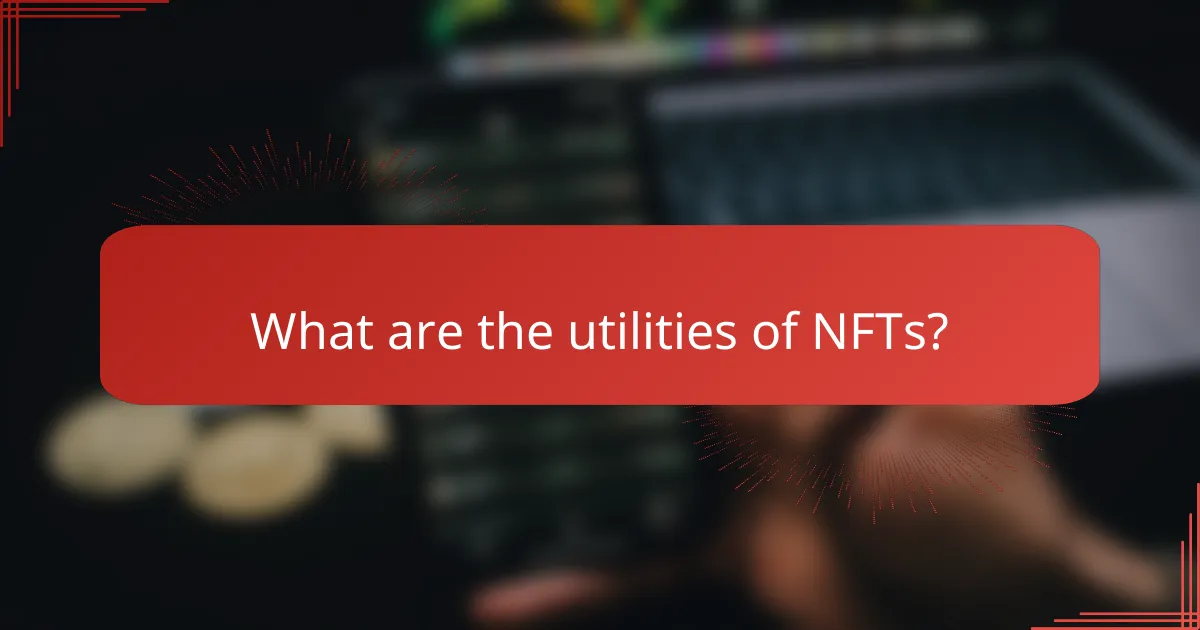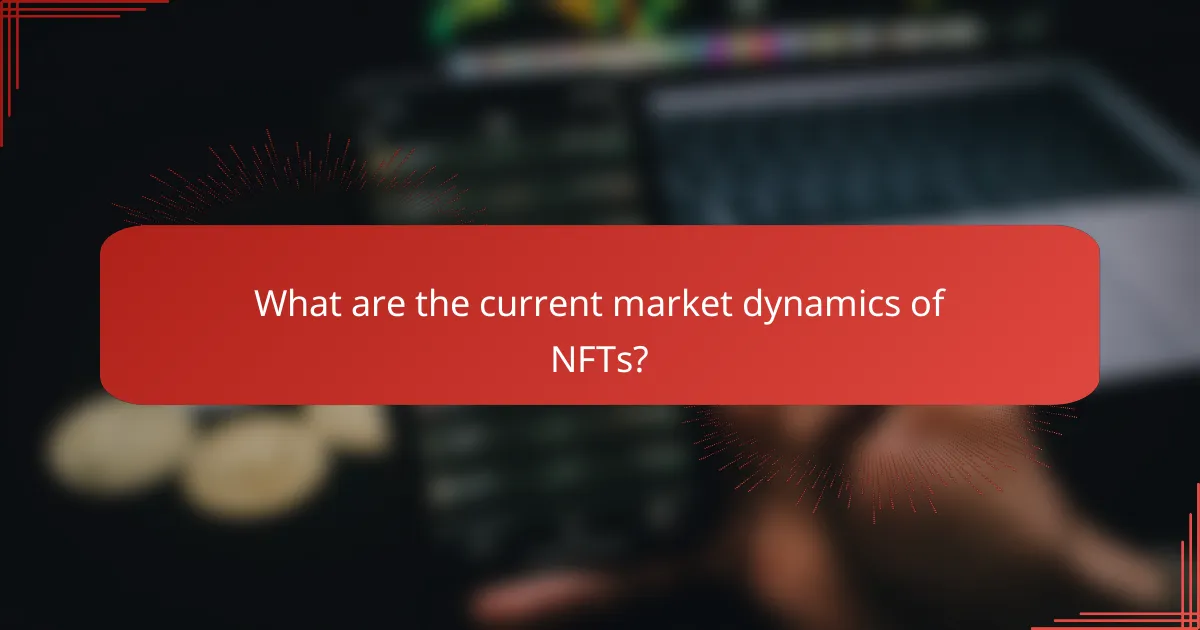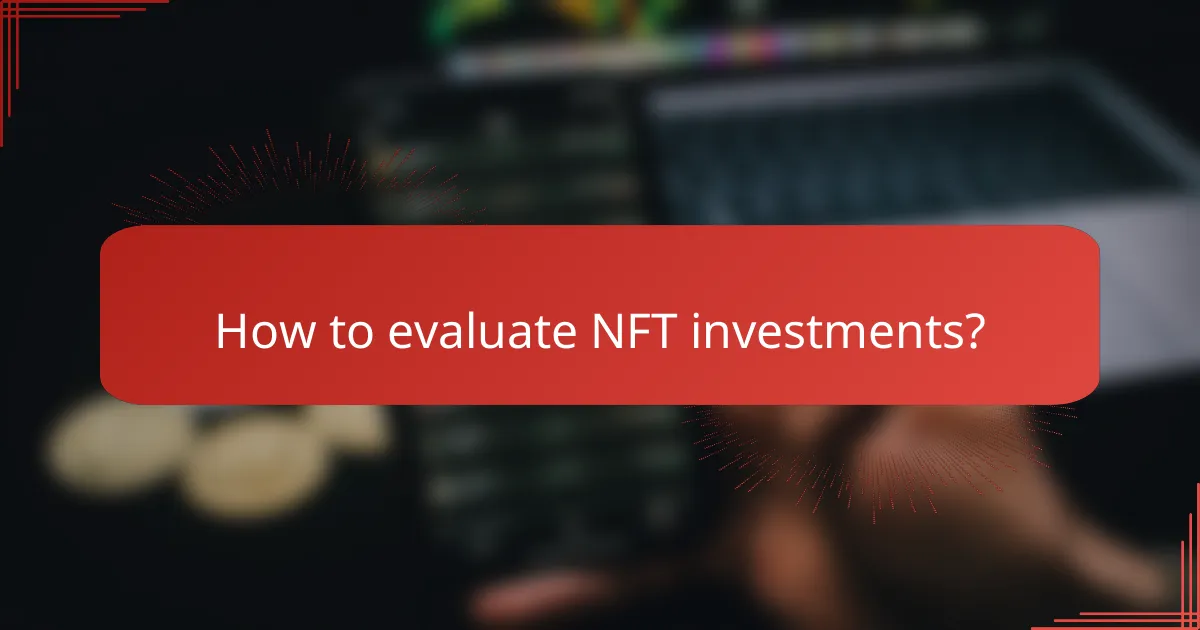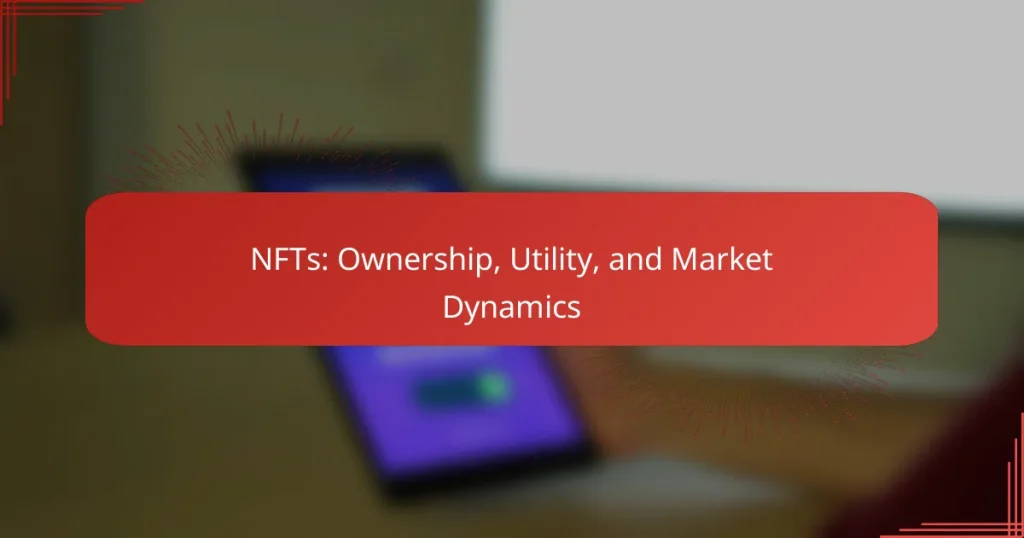NFTs, or non-fungible tokens, revolutionize digital ownership by representing unique assets on a blockchain, ensuring each token is distinct and verifiable. Beyond ownership, they provide various utilities, such as access to exclusive content and creator royalties, enhancing their value in digital ecosystems. The evolving market dynamics of NFTs are shaped by demand, innovation, and investor sentiment, with factors like utility and community engagement playing crucial roles in their valuation.

How do NFTs provide ownership?
NFTs, or non-fungible tokens, provide ownership by representing unique digital assets on a blockchain, ensuring that each token is distinct and verifiable. This ownership is secured through cryptographic methods, making it difficult to counterfeit or duplicate the asset.
Digital asset verification
Digital asset verification is a key feature of NFTs, allowing buyers to confirm the authenticity and ownership of a digital item. Each NFT contains metadata that links it to a specific asset, which can include art, music, or virtual real estate. This verification process helps prevent fraud and ensures that buyers are purchasing genuine items.
Smart contract functionality
Smart contracts are self-executing contracts with the terms of the agreement directly written into code. In the context of NFTs, smart contracts automate the transfer of ownership and enforce royalties for creators whenever the NFT is resold. This functionality provides a transparent and efficient way to manage ownership rights and transactions.
Decentralized ledger technology
Decentralized ledger technology, primarily blockchain, underpins the operation of NFTs by recording all transactions in a secure and immutable manner. This technology ensures that ownership records are publicly accessible and tamper-proof, allowing anyone to verify the history of an NFT. As a result, buyers can have confidence in the legitimacy of their purchase.

What are the utilities of NFTs?
NFTs, or non-fungible tokens, offer various utilities that extend beyond mere ownership, enhancing their value in digital ecosystems. These utilities include access to exclusive content, membership in virtual communities, and royalties for creators, each contributing to the growing significance of NFTs in the digital landscape.
Access to exclusive content
NFTs can grant holders access to unique digital content that is not available to the general public. This may include limited edition artwork, music tracks, or virtual experiences that can only be unlocked through ownership of the NFT.
For example, an artist might release a special album version as an NFT, allowing buyers to listen to unreleased tracks or gain backstage passes to concerts. This creates a direct connection between creators and their audience, enhancing the value of the NFT.
Membership in virtual communities
Owning certain NFTs can provide membership in exclusive virtual communities, often tied to specific interests or brands. These communities may offer networking opportunities, special events, or unique experiences that foster engagement among members.
For instance, some NFT projects include access to private Discord servers or virtual meetups, where members can interact with creators and other collectors. This sense of belonging can significantly enhance the perceived value of the NFT.
Royalties for creators
NFTs can be programmed to ensure that creators receive royalties every time their work is resold, providing a continuous revenue stream. This feature is particularly appealing in the art world, where traditional sales often leave artists without further compensation.
Typically, royalties can range from 5% to 15% of the resale price, depending on the agreement set by the creator. This not only incentivizes artists to create but also aligns their interests with the long-term value of their work in the market.

What are the current market dynamics of NFTs?
The current market dynamics of NFTs reflect a complex interplay of demand, innovation, and investor sentiment. As the market evolves, factors such as utility, community engagement, and technological advancements significantly influence NFT valuations and trading behaviors.
Market trends in 2023
In 2023, the NFT market has seen a resurgence in interest, driven by new use cases and mainstream adoption. Brands and artists are increasingly leveraging NFTs for marketing and fan engagement, leading to a broader acceptance beyond digital art.
Additionally, the integration of NFTs with metaverse platforms has created new opportunities for virtual real estate and experiences. This trend is attracting both individual collectors and institutional investors, further diversifying the market landscape.
Top NFT marketplaces
Some of the leading NFT marketplaces in 2023 include OpenSea, Rarible, and Foundation. OpenSea remains the largest platform, offering a wide variety of digital assets, while Rarible focuses on community-driven initiatives and creator royalties.
Foundation caters to artists and curators, emphasizing quality over quantity. Each marketplace has unique features, so it’s essential for buyers and sellers to evaluate which platform aligns best with their goals and the types of NFTs they wish to trade.
Price volatility factors
Price volatility in the NFT market is influenced by several factors, including market sentiment, rarity, and the overall economic environment. Rapid shifts in buyer interest can lead to significant price fluctuations, making it crucial for investors to stay informed about trends and news.
Additionally, the uniqueness of an NFT, such as its creator’s reputation and the community surrounding it, can greatly affect its value. Investors should be cautious and conduct thorough research to avoid common pitfalls associated with speculative buying.

How to evaluate NFT investments?
To evaluate NFT investments, consider factors such as rarity, creator reputation, and market liquidity. These elements can significantly influence an NFT’s potential value and resale opportunities.
Assessing rarity and demand
Rarity is a crucial factor in determining an NFT’s value. Unique or limited-edition NFTs often command higher prices due to their scarcity. Check the total supply and the number of existing owners to gauge demand.
Tools like Rarity.tools can help you analyze the rarity of specific NFTs within a collection. A higher rarity score typically correlates with increased demand, making it a key consideration in your investment strategy.
Understanding creator reputation
The reputation of the NFT creator can greatly impact the asset’s value. Established artists or brands often attract more buyers, leading to higher prices. Research the creator’s previous works, sales history, and community engagement to assess their standing.
Look for verified accounts on platforms like OpenSea or Rarible, as these often indicate a level of trustworthiness. A strong following and positive reviews can also signal a creator’s potential for future success.
Evaluating market liquidity
Market liquidity refers to how easily an NFT can be bought or sold without significantly affecting its price. High liquidity is desirable, as it allows for quicker transactions and less price volatility. Check recent sales data to understand how quickly similar NFTs are moving in the market.
Consider the platform where the NFT is listed; some marketplaces have more active user bases than others. Additionally, assess the average time it takes for similar NFTs to sell, which can provide insight into potential liquidity challenges.

What are the risks associated with NFTs?
NFTs carry several risks that potential buyers and investors should consider, including market manipulation, legal uncertainties, and security vulnerabilities. Understanding these risks can help individuals make informed decisions in the volatile NFT marketplace.
Market manipulation concerns
Market manipulation is a significant risk in the NFT space, where prices can be artificially inflated through tactics like wash trading. This occurs when individuals or groups buy and sell the same NFT among themselves to create the illusion of demand, misleading other buyers.
Investors should be cautious and conduct thorough research before purchasing NFTs. Look for transparent sales history and avoid projects that exhibit suspicious trading patterns, as these may indicate potential manipulation.
Legal and regulatory challenges
The legal landscape surrounding NFTs is still evolving, leading to uncertainties regarding ownership rights and intellectual property. Different countries may have varying regulations, which can affect the validity of NFT ownership and the enforcement of rights.
Before investing in NFTs, familiarize yourself with local laws and regulations. Consult legal experts if necessary to ensure compliance and understand the implications of your purchases, especially in jurisdictions with strict digital asset laws.
Security vulnerabilities
Security vulnerabilities pose a significant risk to NFT holders, as digital assets can be susceptible to hacks and scams. Phishing attacks, where malicious actors trick users into revealing their private keys, are common in the NFT space.
To mitigate security risks, use reputable wallets and platforms, enable two-factor authentication, and be cautious of unsolicited communications. Regularly update your security practices to protect your digital assets from potential threats.


